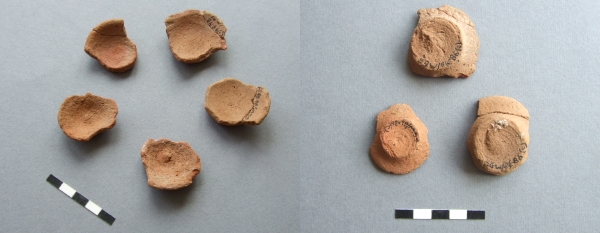 The image for Day 304 of the VM_365 project shows two images of a group of small ceramic vessels of a type that have been called tazza, a term derived from the Italian word for a cup. The image on the left shows the upper surface of the vessels, the right hand image shows the bases of three of them.
The image for Day 304 of the VM_365 project shows two images of a group of small ceramic vessels of a type that have been called tazza, a term derived from the Italian word for a cup. The image on the left shows the upper surface of the vessels, the right hand image shows the bases of three of them.The term Tazza occurs in archaeological literature mainly in reference to elegant Late Iron Age and Early Roman pedestalled cups or goblets of Gallo-Belgic origin. The vessel design is ultimately stimulated by Roman originals and their British counterparts in Late Iron Age grog-tempered ‘Belgic’ style. The term tazzeti occurs less frequently but has been used in reference to the cluster of little saucer-like vessels shown in the images.
Seven of these small tazzetti, complete or broken, were recovered from an excavation in the 1980s near the Sunken Gardens at Westbrook, which was led by David Perkins. The vessels are wheel-made. The image on the right shows the characteristic whorl, typical of many wheel made pots, on the upturned bases of three of the pots that show the whorls most clearly.
The tiny cups are made in a sandy fabric, very similar to the products of many Roman pottery kilns in Canterbury made between c.75-175 AD. They fact that they are not very hard-fired suggests a likely manufacturing date between c.75 or 100-150 AD.
But what were they used for? There is no certain answer.
The small cups are a rare vessel type and nothing quite like these has been found in Thanet or the East Kent region before. The only clues may lie among the finds associated with the cups which include several fragments of pseudo-marble wall facing and a small rounded quartz pebble. Perhaps the quartz pebble could is no more than an object picked up by a child from the beach nearby, but the rounded and semi-translucent nature of the pebble might have been considered ‘special’ by an adult.
The occurrence of both the unusual little dishes and the pseudo marble seems altogether different and ‘special’. The ‘marble’ is not true marble, but is composed of broken fragments of genuine red and green marble deliberately added to a fine white mortar, which is polished so that the whole mix of small inclusions shines like genuine colour-flecked marble. A similar technique called Terazzo is still used to create wall and floor finishes.
The marble finish suggests the presence of a building with a pretension to opulence, although the community was not rich enough to afford the real thing but had enough resources to have a reasonable facsimile created. In turn this suggests that the ‘marble’ fragments could come from the wall of a domestic shrine belonging to a fairly well-to-do family, or just possibly a public shrine or temple.
Whatever the context of discovery, a reasonable explanation for the use of these little vessels in the Roman period is as little offering dishes